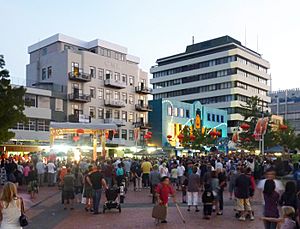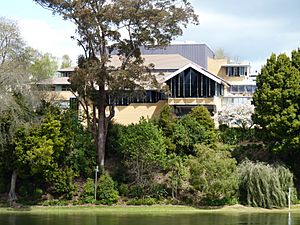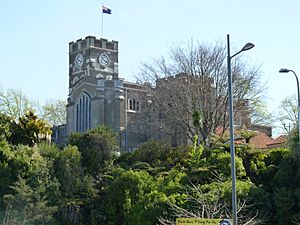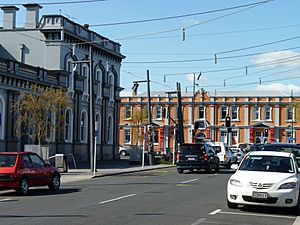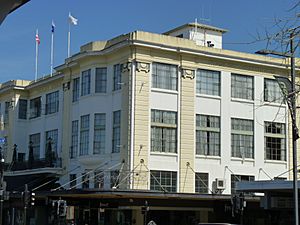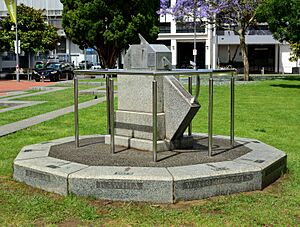Hamilton Central facts for kids
|
|
||
Hamilton Central is the main downtown area of Hamilton, New Zealand. It sits on the western side of the Waikato River. This area is the heart of the city, where many businesses, shops, and important buildings are located.
Contents
- Understanding Hamilton Central's Population
- Exploring Hamilton Central's Key Places
- Victoria Street: Hamilton's Main Road
- Garden Place: A Central Gathering Spot
- Hood Street Precinct: Dining and Fun
- Casabella Lane: A Unique Shopping Area
- Waikato Institute of Technology (Wintec)
- Founders Theatre: A Historic Venue
- Waikato Museum: Exploring History and Art
- The Meteor: A Creative Space
- Clarence Street Theatre: A Performance Hub
- Historic Buildings in Hamilton Central
- St Peter's Cathedral: A Place of Worship
- ArtsPost / Hamilton Post Office Building: From Mail to Art
- Hamilton Hotel: A Historic Stay
- Casino: Entertainment Hub
- Bank of New Zealand Building: A Grand Bank
- Wesley Chambers: Hamilton's First Skyscraper
- Hamilton Courthouse: Justice in Action
- Municipal Baths: A Former Swimming Spot
- Public Art and Statues in Hamilton Central
Understanding Hamilton Central's Population
Hamilton Central covers about 1.02 square kilometers. As of 2023, it has an estimated population of 740 people. This means there are about 725 people living in each square kilometer. Hamilton North is also considered part of this central area.
In 2018, Hamilton Central had 798 residents. This was an increase from previous years. The median age was 31.8 years old. About 41% of the people living here were aged 15 to 29.
People from many different backgrounds live in Hamilton Central. The main ethnic groups include European/Pākehā, Māori, Asian, and Pacific peoples. Many residents were born outside of New Zealand.
When it comes to religion, many people in Hamilton Central do not have a religious belief. Others identify as Christian, Hindu, Buddhist, or other religions. Some follow Māori religious beliefs.
Many people in Hamilton Central have a university degree. The median income was $24,600. About 47.8% of people aged 15 or older worked full-time.
Exploring Hamilton Central's Key Places
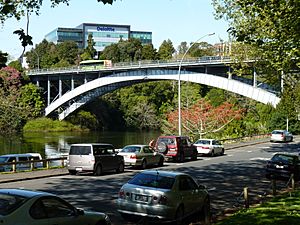
Victoria Street: Hamilton's Main Road
Victoria Street is Hamilton's most important street. It runs right next to the Waikato River. The street is named after Queen Victoria. It starts near Victoria Bridge and goes quite a long way. The part with most of the shops and businesses ends before Whitiora Bridge. Many of Hamilton's historic buildings, 33 of them, are found on Victoria Street.
You can find many cool places to eat and drink here. Centre Place is a shopping mall that opened in 1985.
Garden Place: A Central Gathering Spot
Just off Victoria Street is Garden Place. This area is a pedestrian mall, meaning it's mostly for people walking, not cars. It was created in the late 1930s by cutting through a hill. This made space for Anglesea Street and later for Garden Place itself.
At first, Garden Place was a car park. But in 1967, it was turned into a park with grass and trees. There used to be a road around the park, but it was removed in 1974. The name Garden Place actually refers to the old road, not just the grassy park area. In 2012, a shared drive-through area was added as part of a new design.
Hood Street Precinct: Dining and Fun
Hood Street is a lively area in Hamilton Central. It's known for having many restaurants and bars. You'll find lots of places to eat and hang out here, as well as on south Victoria Street and Alexandra Street. The street is named after an English humorist named Thomas Hood.
Casabella Lane: A Unique Shopping Area
Casabella Lane is a special lane in Hamilton North. It's designed in a Spanish style. It has 21 small shops and 9 apartments. It was built around the year 2000.
Waikato Institute of Technology (Wintec)
The Waikato Institute of Technology, also known as Wintec, is one of New Zealand's biggest polytechnics. Its main campus is in the city center. It's located between Anglesea Street and Tristram Street, close to the Hamilton City Council buildings.
Founders Theatre: A Historic Venue
Founders Theatre in Hamilton North opened in 1961. Unfortunately, it is now considered unsafe due to earthquake risks and will be taken down.
Waikato Museum: Exploring History and Art
The Waikato Museum opened in 1987. It was designed by Ivan Mercep, who also designed New Zealand's national museum, Te Papa. The museum has five levels and 13 galleries. It holds over 38,000 items related to Māori culture (tangata whenua), art, science, and social history. The Te Winika Gallery features a special 200-year-old carved Māori war canoe called Te Whare Waka o Te Winika.
The Meteor: A Creative Space
The Meteor is Hamilton's black box theatre. It's located at the corner of Victoria Street and Bridge Street. This building used to be a soft-drink factory and a roller-skating rink. It was later turned into a theatre. It also has spaces on the first floor for new creative businesses. This area is called Soda Inc.
Clarence Street Theatre: A Performance Hub
Clarence Street Theatre is a theatre that can hold 550 people. It has a unique De Stijl style on the outside. The building was first developed by the Hamilton Operatic Society and was known as the Drury Lane Theatre. The current theatre was finished in 1987. It has hosted many plays, comedy shows, and smaller concerts.
Historic Buildings in Hamilton Central
St Peter's Cathedral: A Place of Worship
St Peter's Cathedral was built using ferro-concrete, a strong type of concrete with steel inside. It was finished in 1916. This is the fourth Anglican church built on this spot. It serves as the main church for the Bishop and Diocese of Waikato. The church stands on a hill where Australian soldiers built a fort to defend Hamilton during a war in the 1860s.
ArtsPost / Hamilton Post Office Building: From Mail to Art
Hamilton's Post and Telegraph Office was built in 1901. It was designed in an Edwardian Baroque style. The building was made bigger in 1916. It was the main post office until 1940. After that, it was used for social welfare and other purposes. The Hamilton City Council bought the building in 1992 and restored it. It reopened as ArtsPost in 1998, becoming a place for art. It is listed as a historic building.
Hamilton Hotel: A Historic Stay
The former Hamilton Hotel at 170-186 Victoria Street was built in 1923. It first opened in 1865. The hotel burned down twice, in 1898 and 1922, before the current building was constructed. It closed in 1980. The front of this historic hotel will be kept as part of a new 1300-seat Waikato Regional Theatre being built.
Casino: Entertainment Hub
The building at 346 Victoria Street was built in 1940. It replaced the 1901 post office. In 1990, it was turned into the Sky City Casino. It has an Art Deco glass and concrete dome.
Bank of New Zealand Building: A Grand Bank
The old Bank of New Zealand building was the biggest of its kind in Hamilton when it was built in 1875. It was designed by Edward Mahoney. The bank moved out in 1986. In 1994, it was renovated and became The Bank Bar and Brasserie. This renovation helped start a big redevelopment project at the south end of Victoria Street.
Wesley Chambers: Hamilton's First Skyscraper
Wesley Chambers was the first multi-story building in Hamilton made of reinforced concrete. It was also the first to have a lift! The building was designed in the Chicago School style. It has special windows and wrought iron balconies.
For many years, the upper floors of Wesley Chambers were used by important professionals like opticians, lawyers, and dentists. In the 1990s, it was turned into a hotel called The Le Grand, which later became the VR Hamilton hotel.
Hamilton Courthouse: Justice in Action
The Hamilton Courthouse is a concrete building on a hill above Anglesea Street. It was built in 1931. It originally had two courtrooms. In 1974, the building was damaged by fire. A new court complex was built next to it in 1993. The old courthouse was empty for ten years, but in 2004, it was restored to be used as a working courthouse again.
Municipal Baths: A Former Swimming Spot
A decision was made in 2020 to allow the demolition of the Municipal Baths at 26 Victoria St. The original entrance was removed in the 1980s. The baths were built in 1912 using reinforced concrete, which was quite early for that type of construction.
Public Art and Statues in Hamilton Central
Riff Raff Statue: A Tribute to a Star
The Riff Raff Statue honors Rocky Horror Picture Show creator Richard O'Brien. He used to live in Hamilton. Weta Workshop created a statue of Riff Raff, a famous character from the show played by O'Brien. The statue was revealed on Victoria Street on November 26, 2004. You can even find a website and webcam for the statue at www.riffraffstatue.org.
Te Tiaho o Matariki: Stars and Nature
Located in Garden Place, Te Tiaho o Matariki was made by Neil Miller. This sculpture shows the Pleiades star cluster, also known as Matariki, as a growing vine with the stars as its fruit. It celebrates the city's first inhabitants, who used Garden Place as a garden and observatory. It also honors the "garden" part of Garden Place. The curving shape of the sculpture also reminds us of the nearby Waikato River.
Ripples: Art Above the River
The Ripples sculpture was created in 1987 for the opening of the Waikato Museum. It hangs in the air, stretching six meters. It's made of a special material called carbon fiber reinforced polyester resin. The sculpture looks like the ripples created when a stone hits water. It hangs about 20 meters high, above the Waikato Museum riverbank. It was created by Christchurch artist Neil Dawson.
Millennium "Koru Family" Sculpture: Celebrating Family
This sculpture is on the bank of the Waikato River. The Koru Family sculpture was given to Hamilton City in 2000 by the Year 2000 Millennium Committee. It was made to celebrate family. The sculpture was created by Carla Van de Veen of Te Aroha and is made of Hinuera Stone.
The Farming Family: A Local Landmark
The Farming Family is a statue located in Hamilton North.
Tongue of the Dog: A Māori Legend in Water
This is a water sculpture that tells a Māori legend about how the Waikato River came to be. You can find it on Victoria Street.
The Garden Place Sundial: Telling Time with the Sun
The Garden Place Sundial is a special sundial with seven different ways to tell time. It includes an Analemma Sundial. It's designed in an Art Deco style. It can show the time based on the sun, clock time, sunrise and sunset times, the date at noon, and important astronomical events like solstices and equinoxes. The sundial is located in front of the Central Library, on the grass lawn in Garden Place. It was given to the City of Hamilton by the Hamilton Astronomical Society in 1937.



